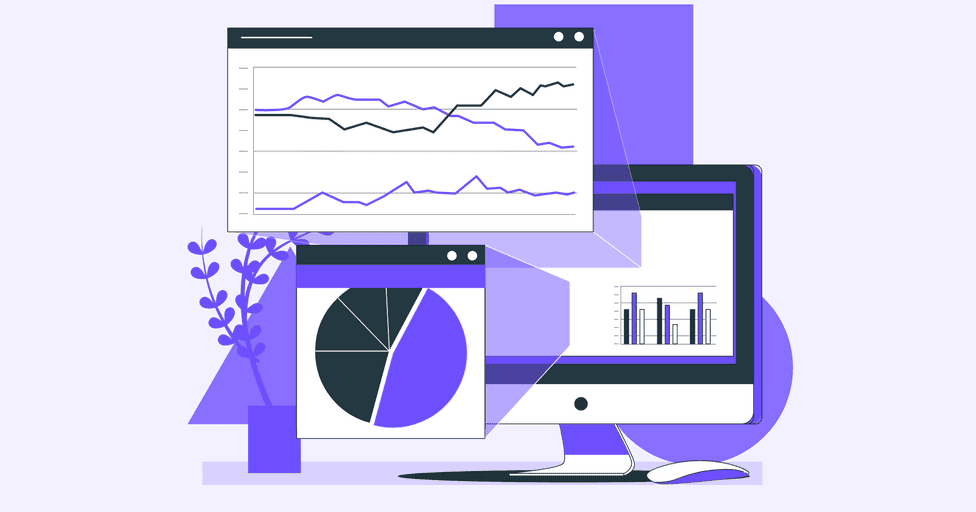Overwhelmed by all the shipping analysis software and solutions out there?
Choosing the right shipping analytics tools can be a game-changer, letting you capture essential delivery data, harness parcel business intelligence, and leverage powerful decisions to enhance your shipping operations.
In this guide, we’ll walk you through the best shipping analytics platforms and share actionable strategies to streamline efficiency and maximize results for your eCommerce.
What is shipping data analytics?
Shipping data analytics is a specialized field that analyzes eCommerce KPIs extracted from shipping and delivery processes. An in-depth shipping analysis includes evaluating routes, carrier efficiency, shipping times, rates, delivery predictions or or even open and conversion rates for shipping notification alerts.
Why you should use shipping analytics software?
The shipment analysis software provides access to essential metrics, such as transportation costs, delivery times, and service reliability—data that is often overlooked. With these insights at your fingertips, you can identify inefficiencies and optimize every stage of the shipping process. Additionally, its real-time tracking feature enables instant issue resolution, enhancing the customer experience and increasing your business's efficiency.
Key Benefits:
- Better control over shipping expenses through detailed monitoring of transportation costs
- Improved supplier and carrier management
- Reduced delivery delays with proactive issue resolution
- Increased customer satisfaction with faster, more reliable deliveries
- Insights into trends to guide future shipping strategy adjustments
The best shipping analytics platforms and tools
1. Outvio

Outvio empowers businesses to take control of their entire post-purchase experience. This comprehensive advanced shipping data software eliminates the need for multiple tools by automating and analyzing shipping, returns, and customer service. Manage everything from carrier logistics and order tracking to product changes, customer interactions, and support chats - all within one user-friendly platform.
Outvio goes beyond automation. By collecting data from your supply chain, carriers, and customer behavior, it unveils valuable trends that inform intelligent decision-making. This allows you to optimize processes and accelerate business growth.
Key Features
- Unified Hub: Centralize all your work in a single, intuitive platform.
- Actionable Analytics: Gain complete visibility into your business performance with comprehensive reporting
- Branded Tracking Experience: Provide a professional and customized tracking experience for your customers with branded tracking pages and email notifications.
- Effortless Invoice Management: Automate invoice checking and streamline financial processes
- Smoother Shipping: Proactively detect and resolve transportation issues to ensure on-time deliveries
- AI-Powered Automations: Leverage intelligent automation tools to automate repetitive tasks and improve efficiency
- Streamlined Invoicing: Achieve automated control over your transportation invoices.
- Seamless Customer Service: Integrate a full-featured chat system for effortless customer interactions
- End-to-End Logistics Control: Manage all order and logistics operations from a single platform
- Simplified Returns & Exchanges: Automate handling of exchanges and returns to reduce workload
2. Reveel
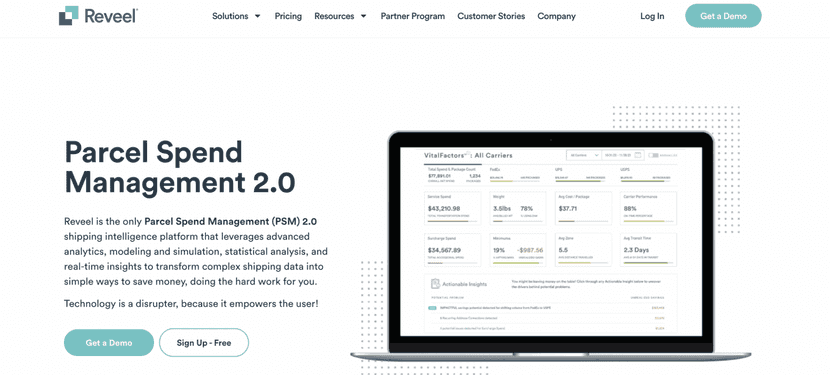
Reveel empowers you to optimize your parcel shipping with powerful analytics. Its user-friendly dashboard centralizes all your shipment data, giving you clear insights into your transportation costs and logistics efficiency.
Key features
- Cost optimization
- Strategic carrier management
- Data-Driven logistics decisions
- Seamless integrations
3. Aftership
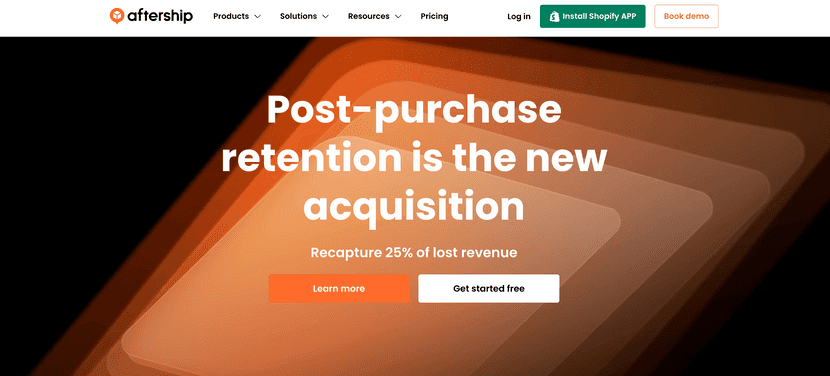
AfterShip is post-purchase experience software divided into integrable modules. It is best known for its shipment tracking system, allowing shops to track packages from multiple carriers and provide tracking information to their customers. With its analytics system, you can monitor many shipping KPIs as well as the performance of your notifications.
Key features
- Unified tracking & automation
- Extensive integrations
- Streamlined Operations
- Data-Driven Optimization
- Integrable modules
4. Parcelperform
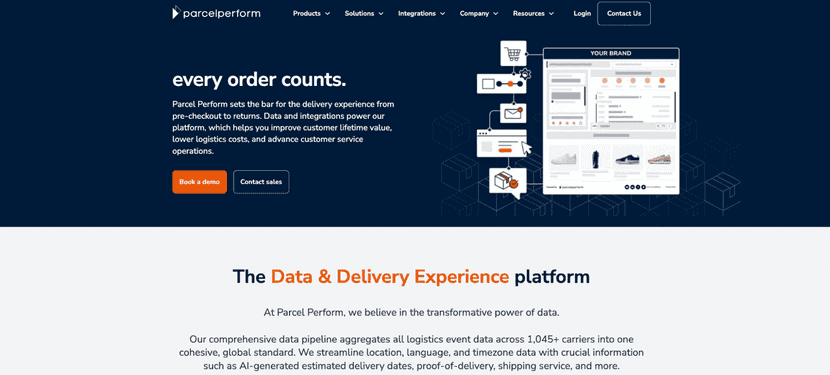
Parcel Perform is a specialized shipping and delivery analytics tool. It leverages data linked to your order stage to understand shopper behavior and help businesses optimize the shopping experience. It also generates reports with other shipping and warehouse logistics KPIs.
Key features
- Unified Customer Insights & Optimization
- Actionable Logistics Reporting
- Seamless Integrations
- Data-Driven Delivery Predictions
5. eShipz

eShipz integrates with multiple carriers, allowing you to compare rates and choose the best option for each shipment. You can automate repetitive tasks such as generating shipping labels, entering tracking information, and tracking packages. The software also has shipment analysis features to help you with your decision-making and logistics strategy.
Key features
- Synchronization of information in a single panel
- Simplification of the transport process
- Label printing
- Fast integration
6. Shiphawk
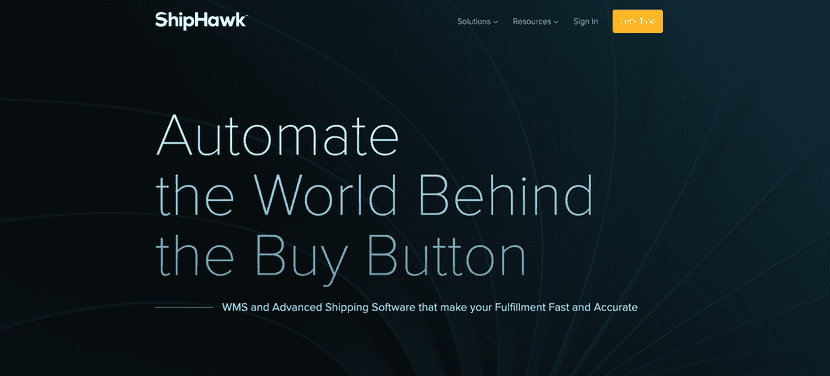
ShipHawk is a fulfillment management solution designed specifically for high-volume companies that use ERP systems such as NetSuite. It aims to automate and improve shipping processes related to warehousing and processing, as well as provide performance analytics to help optimize strategies.
Features include
- Integrated warehouse management system
- Product packaging system
- Pick list creation
- Inventory and stock rotation analysis
7. Parcellab
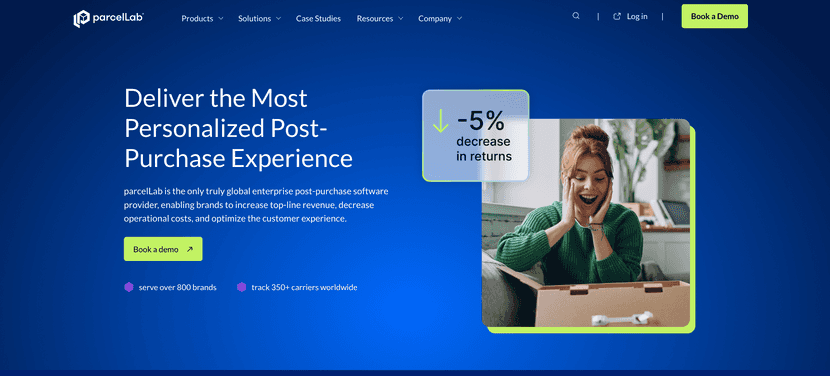
ParcelLab is a shipping and delivery analytics software with the ability to automate tracking, marketing, and customer experience tasks. With ParcelLab, you will be able to monitor most of the shipping KPIs, especially those related to reducing operational costs and increasing sales through an optimized post-purchase experience.
Key features
- Monitoring customer behavior
- Customizable order notifications
- Analysis of incidents during shipping and delivery
- Automation of post-purchase marketing
8. Tracey
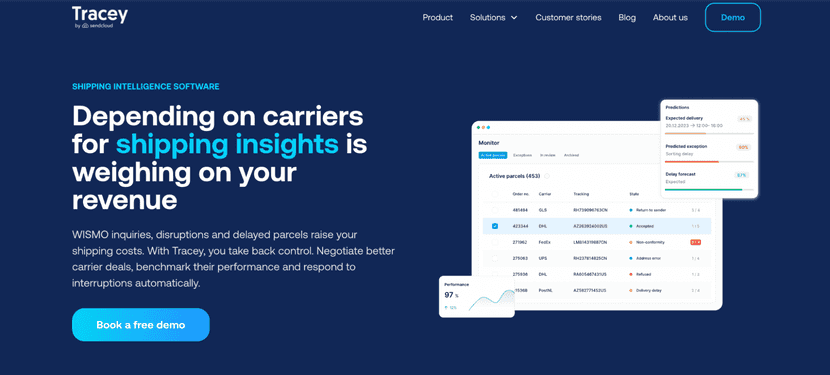
Tracey is shipment and delivery tracking and analysis software. You can send automatic notifications of changes in the status of your shipments and deliveries. Additionally, it allows you to monitor the performance of your logistics providers and optimize strategic decision-making.
Key features
- Track and analyze shipment data to identify areas for improvement
- Compare and negotiate rates with different carriers
- Automate tasks like booking shipments and generating labels
- Gain insights into carrier performance and identify potential disruptions
9. Shipup
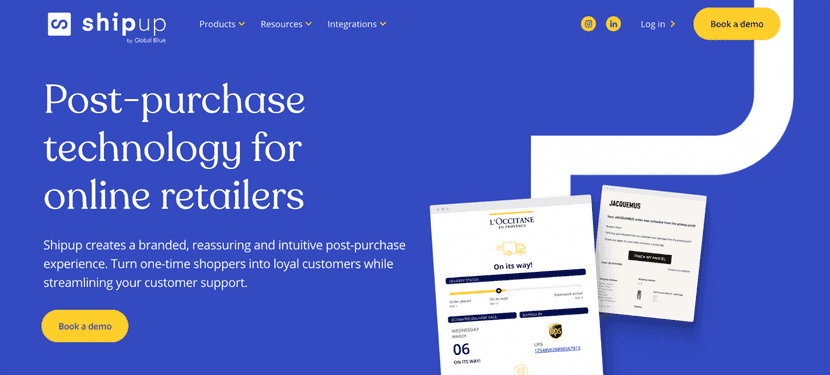
Shipup is a technology platform that helps you efficiently manage the after-sales of your online shop. This shipping analysis software reviews carrier rates to find the most economical option and provides you with tools for much of the shipping and delivery process.
Key features
- Task automation
- Real-time alerting system
- Package shipment and delivery tracking
- CSV reporting
10. Shipwell
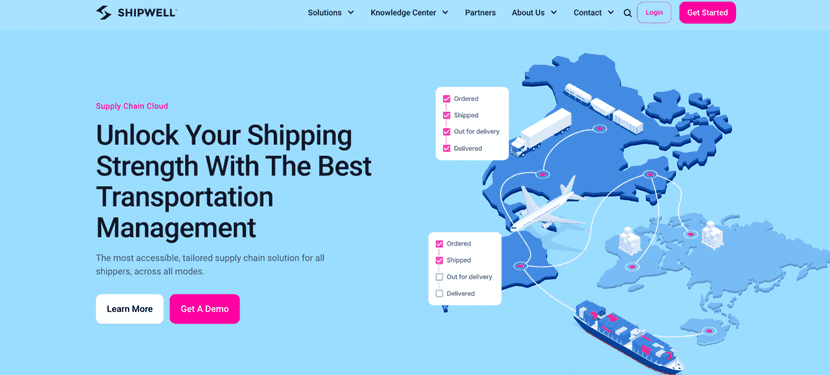
Shipwell is a multimodal transport management software with shipment analysis functionalities. These functions can be used to identify trends, improve efficiency, and reduce logistics and transport costs.
Key functionalities
- Shipping cost optimization
- Carrier management
- Dynamic route planning
- Multimodal platform
11. Narvar
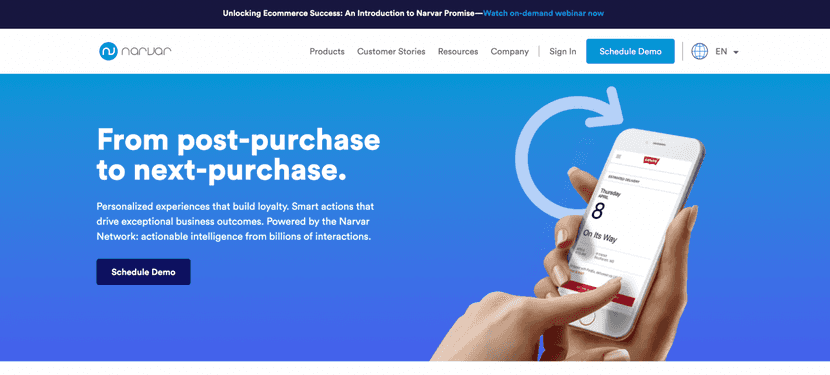
Narvar is a returns and tracking management platform that improves the customer experience by simplifying the returns process and providing data analytics to identify the causes of returns and take corrective action. Narvar increases customer satisfaction and reduces return costs.
Key features
- Portal and tracking notifications
- Personalization and branding capabilities
- Order status monitoring
- Returns automation
12. Logistaas
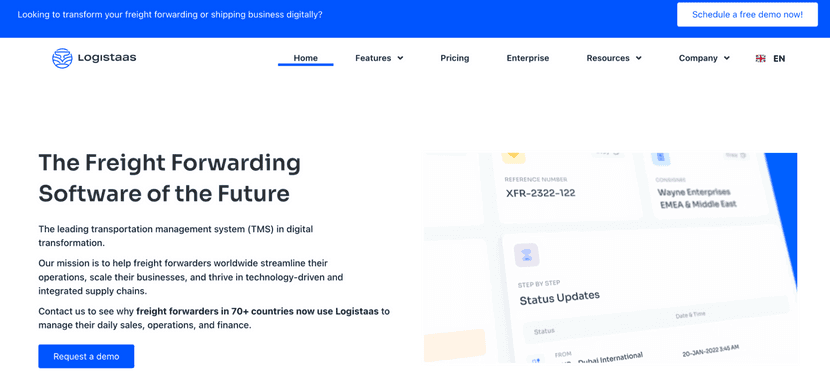
Logistaas is a cloud-based software platform designed specifically for logistics companies, such as freight forwarders. It functions as a transport management system that helps these companies manage their operations and analyze logistics and shipping processes.
Key features include
- Freight tracking
- Shipment analytics and freight reporting
- Integration with other supply chain systems
- Customer portal
- Invoicing tool included
13. Nshift
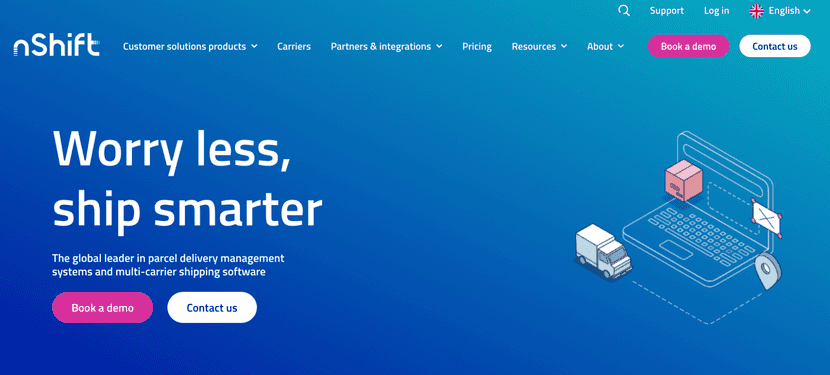
Nshift is a carrier aggregator with shipping and returns analytics functionality. In addition to managing orders and printing labels, you can monitor different transport KPIs, improve routes, or identify the carriers with the best performance for your business.
Key features
- Integrations with carriers and logistics providers
- Control of the environmental impact of deliveries
- Automatic shipment tracking and notification
- Transport data extraction
- Returns and exchange management suite
14. Shipmondo
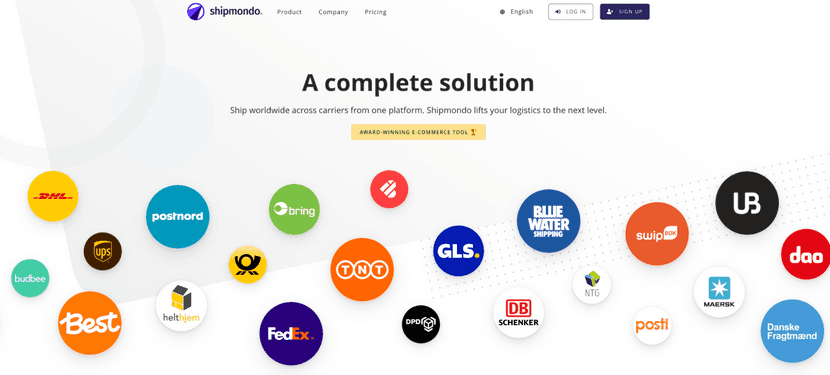
Shipmondo provides detailed reports on shipments, including carrier, destination, cost, and shipment status. You can filter reports by date, carrier, destination, product, and other variables to obtain specific information.
Key Features
- Shipping automation
- Order tracking and notifications
- Rate control
- Integration with other software and eCommerce platforms
15. ShipScience
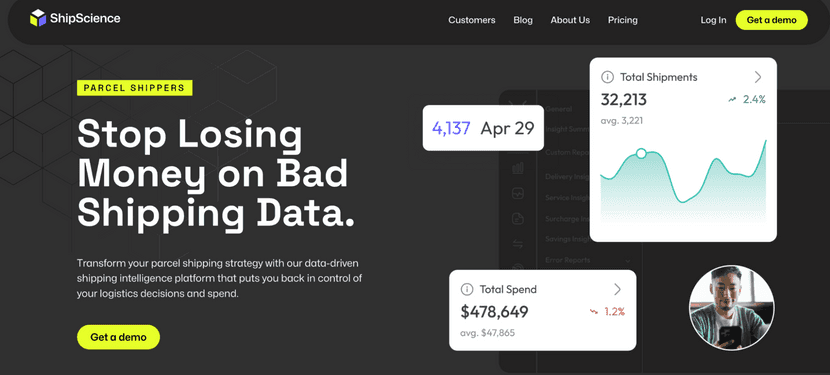
ShipScience is a cloud-based software platform that helps companies optimize their shipping operations. The platform provides a range of tools that enable companies to track shipments, manage inventories, optimize routes, and reduce costs.
Key features include
- Shipment tracking and notifications
- Reporting and dashboard with KPIs
- Claims automation
- Rate and contract of carriage control
16. Lojistic
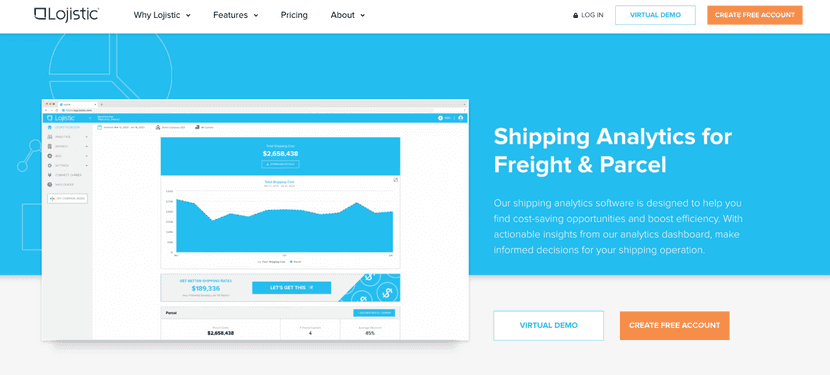
Lojistic is a cost-saving analytics and automation software company designed to help companies control and reduce their shipping costs. Lojistic's platform analyzes a company's historical shipping data, identifies costly shipping inefficiencies, and provides solutions to resolve those issues.
Key functionalities
- Shipping invoice management
- Carrier and logistics operator aggregation
- Shipping rate comparison
- Shipping analytics and reporting
- Integration with other enterprise software
How to use data from parcel shipping analytics solution
Parcel delivery analysis software can be a powerful tool for businesses of all sizes. Here's a detailed look at how to leverage its data for maximum benefit:
Identifying efficient carriers and services
- Cost-Performance analysis: Go beyond just price. Analyze cost per shipment based on weight, distance, and service level (e.g., overnight vs. standard). Identify the most cost-effective carrier for different scenarios.
- Delivery time analysis: Track on-time delivery rates for each carrier across different service levels. Look for patterns and identify carriers consistently meeting (or exceeding) promised timeframes.
- Reliability analysis: Analyze data on lost, damaged, or delayed packages for each carrier. Identify reliable carriers with low error rates to ensure customer satisfaction.
- Benchmarking: Compare your carrier performance metrics with industry benchmarks to see how you stack up. This can help identify areas for improvement or validate your existing choices.
- Negotiation leverage: Use your data-driven insights to negotiate better rates with carriers. Highlight areas where their performance is subpar to incentivize them to offer more competitive pricing.
Reducing shipping errors
- Error tracking: Identify common error types by analyzing tracking data. Look for patterns like frequent address corrections, delays at specific sorting facilities, or high damage rates on specific routes.
- Root cause analysis: Dig deeper into error types to pinpoint the root cause. This could be packaging issues, order fulfillment mistakes, carrier handling problems, or inaccurate address collection practices.
- Process improvement: Based on the identified root causes, implement corrective actions. This can involve improving packaging materials, adding address verification steps, or collaborating with carriers to address specific handling issues.
- Real-time alerts: Set up alerts within the software to notify you of potential errors. This could be triggered by factors like incorrect address formats or exceeding weight limits for chosen services.
Identifying shipping trends
- Geographical analysis: Analyze shipping data by location. This can reveal patterns in demand for specific products in certain regions, influencing inventory allocation and targeted marketing strategies.
- Product analysis: Identify best-selling products and analyze their shipping trends. This can help optimize packaging strategies for specific product types and sizes.
- Shipping method analysis: See which shipping methods are most popular with your customers. This can inform future pricing strategies and service offerings.
- Predictive analytics: Utilize the software's capabilities to forecast future shipping needs based on historical trends and seasonal variations. This can help with inventory planning and resource allocation.
Reducing returns
- Reason analysis: Categorize returns by reason (e.g., damaged product, wrong item, size mismatch). This helps identify areas for improvement in product quality, order fulfillment accuracy, or providing accurate sizing information.
- Product analysis: Identify products with high return rates. Investigate the reasons and take corrective actions such as improving product quality control or providing more detailed product descriptions.
- Packaging analysis: Analyze damage-related returns to assess the effectiveness of your packaging for specific product types. Make adjustments to ensure adequate protection during transit.
Personalizing customer communications
- Targeted communication: Use shipping data to segment your customer base based on purchase and shipping history. Send personalized emails with follow-up offers, product recommendations, or post-purchase surveys relevant to their recent shipment.
- Proactive updates: Utilize shipment tracking data to proactively communicate with customers about potential delays or delivery exceptions. This helps manage expectations and maintain customer satisfaction.
Increasing support department productivity
- Issue categorization: Categorize customer support inquiries related to shipping issues like delays, damages, or missing packages. This helps identify recurring problems and prioritize areas for improvement.
- Knowledge base creation: Based on frequently asked questions, develop a knowledge base with self-service solutions for common shipping issues. This reduces support agent workload and empowers customers to resolve issues on their own.
- Process improvement: Identify areas where shipping processes are leading to customer support inquiries. This could involve improving order confirmation emails to ensure accurate address collection or providing clearer communication about shipping timelines.
How to identify advanced shipping analytics software
Efficient shipment management goes beyond simply coordinating with carriers and ensuring deliveries. A holistic view encompassing internal order processing, returns management, and robust customer support is essential to optimize costs and ensure customer satisfaction.
Limiting your analysis to basic shipping software offers a narrow perspective. These solutions often overlook key aspects like returns and internal workflows, potentially leading to hidden costs and frustrated customers. Additionally, fragmented data from multiple systems makes it difficult to identify improvement opportunities. This often results in costly migrations or integrations with additional software down the line.
Recommend to read
Learn how to professionally manage your eCommerce shipments.
Selecting the right solution: It's all about data
When evaluating shipping analysis software, prioritize solutions that capture data across your entire shipping cycle, encompassing both outbound deliveries and returns. Here's how this benefits your business:
- Comprehensive Data Insights: Gain a unified view of your entire shipping operation. This empowers data-driven decision-making for cost reduction, service improvement, and enhanced customer experiences.
- Streamlined Workflows: Eliminate the complexity and potential inconsistencies of managing separate systems for outbound and return shipments. A unified platform simplifies your workflow, improves data accuracy, and reduces the burden on your IT team.
- Enhanced Efficiency: By minimizing the need for integrations and avoiding potential technical glitches, you streamline data analysis and save valuable time and resources.
How much does shipping analytics software cost? Pricing 2024
| Software | Main Feature | Price | Free Plan |
|---|---|---|---|
| Outvio | Unified Hub for post-purchase, returns and support experience | Starting at €125/month | Yes |
| Reveel | Cost Optimization and Strategic Carrier Management | Customized pricing | Yes |
| AfterShip | Unified Tracking & Automation | Starting at $9/month | Yes |
| Parcel Perform | Unified Customer Insights & Optimization | Customized pricing | No |
| eShipz | Multi-carrier Integration and Shipment Analysis | Customized pricing | No |
| ShipHawk | Fulfillment Management with ERP Integration | Customized pricing | No |
| ParcelLab | Automated Tracking and Customer Experience Tasks | Customized pricing | No |
| Tracey | Shipment and Delivery Tracking and Analysis | Customized pricing | No |
| Shipup | After-sales Management and Shipping Efficiency Tools | Customized pricing | No |
| Shipwell | Multimodal Transport Management with Shipment Analysis | Customized pricing | No |
| Narvar | Returns Management with Customer Experience Improvement | Customized pricing | No |
| Logistaas | Cloud-based Transport Management with Analytics | Customized pricing | No |
| Nshift | Carrier Aggregation with Shipping and Returns Analytics | Customized pricing | No |
| Shipmondo | Detailed Reports and Shipping Automation | Starting from €0.08/shipment | No |
| ShipScience | Cloud-based Shipping Optimization Platform | Customized pricing | No |
| Lojistic | Cost-saving Analytics and Automation Software | Free account with optional paid add-ons | Yes |
Conclusion
Choosing the right shipping analytics software isn't just about efficiency; it's an investment in your business's future.
The key lies in understanding your current pain points. Do you need real-time tracking to address delivery delays? Perhaps route optimization to reduce costs? Prioritize features that directly tackle these challenges.
Think beyond today. As your business scales, your shipping needs will evolve. Select a scalable solution that can grow with you, eliminating the need for disruptive software migrations down the line. Look for a provider with a proven track record of supporting businesses through growth stages.
By carefully considering these factors, you'll choose a shipping analytics solution that streamlines operations today and positions your business for long-term success.

